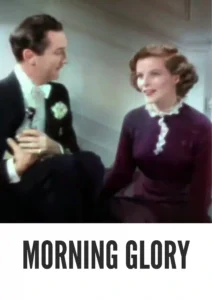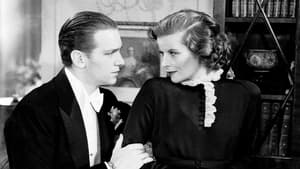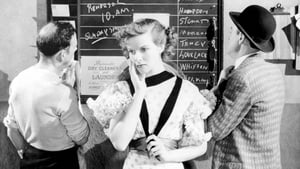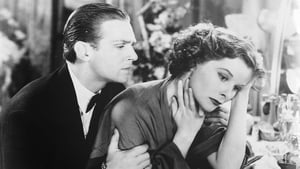Contact: info@alwanfilm.com
Video Sources 0 Views

Synopsis
Morning Glory 1933 Colorized Review: A Theatrical Journey Through Dreams and Ambition

Introduction
In the realm of early 20th-century cinema, Morning Glory (1933) stands out as a poignant exploration of ambition, talent, and the complexities of the theater world. Directed by the talented Lowell Sherman, this film takes viewers on a journey through the highs and lows of an aspiring actress striving for success on Broadway. Not only does it showcase the intricate dynamics of the theatrical community, but it also highlights the personal sacrifices that come with chasing one’s dreams. The film’s release during the Great Depression adds another layer of significance, resonating with audiences facing their own challenges. In this review, we will examine the film’s impact, performances, and enduring relevance in the context of cinematic history.
Check The Full Colorized Movies List
Check Our Colorized Movies Trailer Channel
Understanding Morning Glory 1933 Colorized: Director, Cast, and Genre
Director’s Vision
Lowell Sherman, both an accomplished actor and director, helmed Morning Glory (1933) with a keen understanding of the theatrical landscape. His vision was to create a film that not only entertained but also delved into the emotional depths of its characters. Sherman’s direction captures the essence of the theater, depicting the thrill and despair that accompany the pursuit of fame. His ability to blend drama with subtle humor allows the film to resonate with audiences, making it a timeless classic.
The Iconic Performance of Actors
At the forefront of Morning Glory (1933) is the remarkable Katharine Hepburn, who delivers an unforgettable performance as Eva Lovelace, a young actress with dreams of stardom. Hepburn’s portrayal is both vibrant and nuanced, showcasing her character’s innocence, ambition, and vulnerability. Her magnetic presence elevates the film, earning her critical acclaim and establishing her as a leading actress in Hollywood.
Joining Hepburn is a talented supporting cast, including Douglas Fairbanks Jr. as the charming and ambitious producer, and Adolphe Menjou as the jaded playwright. Their performances add depth to the narrative, highlighting the challenges faced by those in the theater industry. The chemistry between the characters is palpable, making their struggles and triumphs feel authentic and relatable.
Exploring the Genre
Morning Glory (1933) falls within the drama genre, with elements of comedy woven throughout the narrative. The film’s focus on the theatrical world allows it to explore themes of ambition, love, and sacrifice. By delving into the lives of aspiring actors, Morning Glory offers a candid portrayal of the challenges faced by those who dare to pursue their dreams in a competitive industry. The film’s ability to balance heartfelt moments with comedic undertones is a testament to Sherman’s skillful direction.
Exploring the World of Morning Glory 1933 Colorized: Plot and Characters
Detailed Synopsis
The story of Morning Glory (1933) revolves around Eva Lovelace, a young and ambitious actress determined to make a name for herself on Broadway. The film opens with Eva arriving in New York City, filled with dreams of stardom and a desire to impress the theater community. Her initial encounters with the industry are fraught with challenges, as she faces rejection and disappointment.
Eva’s fortunes change when she meets a successful playwright, Joe Ransome (played by Adolphe Menjou), who recognizes her talent and offers her a leading role in his new play. As she navigates the highs of opening night and the lows of backstage drama, Eva must confront the reality of her ambitions and the sacrifices that come with them.
Throughout the film, Eva’s relationships with her fellow actors, including the charming producer (Douglas Fairbanks Jr.), are central to the narrative. The film delves into the complexities of these relationships, highlighting the personal and professional challenges faced by those striving for success.
Memorable Supporting Characters
The supporting characters in Morning Glory (1933) play pivotal roles in shaping Eva’s journey. Joe Ransome, the playwright, represents both a mentor and a source of conflict for Eva, as their relationship evolves amidst the pressures of the theater world. The character of the producer provides a romantic interest and a glimpse into the business side of the industry, emphasizing the sacrifices actors must make for their careers.
The ensemble cast, including various actors and backstage staff, adds richness to the story, creating a vibrant tapestry of personalities that reflect the diverse experiences within the theater community.
The Art of Theatrical Storytelling
Understanding the Craft of Acting
Morning Glory (1933) offers a glimpse into the art of acting and the dedication required to succeed in the theater. The film explores the challenges faced by actors, from the pressure to perform flawlessly on stage to the emotional toll of their craft. Through Eva’s journey, viewers gain insight into the sacrifices made by those pursuing a career in acting, emphasizing the commitment and passion necessary to thrive in such a demanding field.
The film’s portrayal of the rehearsal process, the excitement of opening night, and the camaraderie among actors showcases the collaborative nature of theater. This emphasis on the artistry of performance adds depth to the narrative, allowing audiences to appreciate the dedication required to create memorable theatrical experiences.
Early 20th Century Theater: A Brief History
The Rise of Broadway
The 1930s marked a significant period in the history of American theater, with Broadway becoming the epicenter of theatrical innovation and creativity. As audiences flocked to the theaters, the demand for new and compelling stories grew, leading to a flourishing of talent and artistry.
Morning Glory (1933) captures the essence of this era, showcasing the excitement and challenges faced by aspiring actors in a rapidly evolving industry. The film reflects the cultural landscape of the time, highlighting the aspirations of individuals striving for success amid the backdrop of the Great Depression.
Morning Glory 1933 Colorized: A Reflection of Its Time
Significance in Film History
The release of Morning Glory (1933) coincided with a period of great economic hardship in the United States. The film’s exploration of ambition and the pursuit of dreams resonated deeply with audiences facing their own struggles. The character of Eva Lovelace serves as a symbol of hope and determination, embodying the spirit of resilience that characterized the era.
Additionally, Morning Glory represents a turning point in Katharine Hepburn’s career, as her performance garnered critical acclaim and established her as a leading actress in Hollywood. The film’s success paved the way for Hepburn’s future roles and solidified her place in cinematic history.
The Legacy of Morning Glory 1933 Colorized
Impact on Future Generations
Morning Glory (1933) continues to influence filmmakers and actors today, serving as a poignant reminder of the challenges and triumphs inherent in the pursuit of artistic dreams. The film’s exploration of ambition and personal sacrifice resonates with aspiring artists across various fields, emphasizing the importance of perseverance in the face of adversity.
The character of Eva Lovelace has become an archetype for aspiring actors, embodying the spirit of determination and the relentless pursuit of success. As a result, Morning Glory remains a relevant and inspiring tale for contemporary audiences, reminding them of the timeless nature of ambition and the theater.
Themes Explored in Morning Glory 1933 Colorized
Ambition and Sacrifice
At its core, Morning Glory (1933) explores themes of ambition and sacrifice, showcasing the lengths to which individuals will go to achieve their dreams. Eva Lovelace’s journey serves as a testament to the challenges faced by those pursuing a career in the arts. The film delves into the emotional toll of ambition, highlighting the sacrifices that actors must make, both personally and professionally.
The relationships within the theater community further emphasize these themes, as characters grapple with their desires for success while navigating the complexities of love and friendship. The interplay between ambition and personal connections adds depth to the narrative, creating a rich tapestry of emotions.
The Reality of the Theater World
Morning Glory also provides a candid portrayal of the theater world, shedding light on the realities of life behind the curtain. The film explores the challenges faced by actors, from the pressures of rehearsals to the uncertainties of opening night. Through Eva’s experiences, viewers gain insight into the dedication required to succeed in the competitive world of theater.
The film’s depiction of the rehearsal process and the camaraderie among cast members emphasizes the collaborative nature of theatrical production. This focus on the behind-the-scenes aspects of theater adds authenticity to the story, allowing audiences to appreciate the artistry involved in creating memorable performances.
Reception and Controversy Surrounding Morning Glory 1933 Colorized
Initial Reviews and Audience Reactions
Upon its release, Morning Glory (1933) received positive reviews from critics, who praised Katharine Hepburn’s standout performance and the film’s engaging narrative. Hepburn’s portrayal of Eva Lovelace was lauded for its emotional depth, establishing her as a force to be reckoned with in Hollywood.
Audiences resonated with the film’s themes of ambition and personal sacrifice, finding solace in Eva’s journey as she navigated the complexities of the theater world. The film’s blend of humor and drama struck a chord with viewers, contributing to its success at the box office.
However, some critics raised concerns about the film’s pacing and its reliance on theatrical tropes. Despite these critiques, Morning Glory remains a beloved classic, appreciated for its exploration of ambition and the artistry of performance.
Where to Watch Morning Glory 1933 Colorized Online
For those interested in experiencing Morning Glory (1933), the film is available on various streaming platforms. Popular services such as Amazon Prime Video and Turner Classic Movies offer access to the film, allowing audiences to enjoy this timeless classic from the comfort of their homes. Additionally, DVD and Blu-ray versions are available for purchase, providing options for collectors and enthusiasts.
FAQs About Morning Glory 1933 Colorized
Q: What is the significance of Morning Glory (1933) in film history?
A: Morning Glory (1933) is significant for its exploration of ambition and personal sacrifice in the theater world, as well as for Katharine Hepburn’s breakthrough performance that established her as a leading actress in Hollywood.
Q: Who directed Morning Glory (1933)?
A: The film was directed by Lowell Sherman, a talented actor and filmmaker known for his work in early Hollywood.
Q: What themes are explored in Morning Glory (1933)?
A: The film explores themes of ambition, sacrifice, and the realities of the theater world, highlighting the emotional toll of pursuing one’s dreams.
Q: How did Morning Glory (1933) impact future generations of filmmakers?
A: The film continues to influence filmmakers and actors, serving as a reminder of the challenges and triumphs inherent in the pursuit of artistic dreams.
Conclusion
Morning Glory (1933) remains a significant film in cinematic history, showcasing the complexities of ambition and the theater world. Katharine Hepburn’s memorable performance, coupled with Lowell Sherman’s adept direction, creates a film that resonates with audiences even today. Its exploration of the sacrifices required to achieve one’s dreams serves as a timeless reminder of the dedication and passion needed in the pursuit of artistic success. As we reflect on the legacy of Morning Glory, it becomes clear that this film not only captures the spirit of its time but continues to inspire generations of artists to chase their dreams, regardless of the obstacles they may face.













